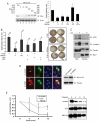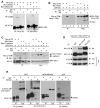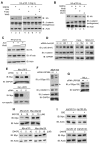Shared molecular mechanisms regulate multiple catenin proteins: canonical Wnt signals and components modulate p120-catenin isoform-1 and additional p120 subfamily members
- PMID: 21098636
- PMCID: PMC2995616
- DOI: 10.1242/jcs.067199
Shared molecular mechanisms regulate multiple catenin proteins: canonical Wnt signals and components modulate p120-catenin isoform-1 and additional p120 subfamily members
Abstract
Wnt signaling pathways have fundamental roles in animal development and tumor progression. Here, employing Xenopus embryos and mammalian cell lines, we report that the degradation machinery of the canonical Wnt pathway modulates p120-catenin protein stability through mechanisms shared with those regulating β-catenin. For example, in common with β-catenin, exogenous expression of destruction complex components, such as GSK3β and axin, promotes degradation of p120-catenin. Again in parallel with β-catenin, reduction of canonical Wnt signals upon depletion of LRP5 and LRP6 results in p120-catenin degradation. At the primary sequence level, we resolved conserved GSK3β phosphorylation sites in the amino-terminal region of p120-catenin present exclusively in isoform-1. Point-mutagenesis of these residues inhibited the association of destruction complex components, such as those involved in ubiquitylation, resulting in stabilization of p120-catenin. Functionally, in line with predictions, p120 stabilization increased its signaling activity in the context of the p120-Kaiso pathway. Importantly, we found that two additional p120-catenin family members, ARVCF-catenin and δ-catenin, associate with axin and are degraded in its presence. Thus, as supported using gain- and loss-of-function approaches in embryo and cell line systems, canonical Wnt signals appear poised to have an impact upon a breadth of catenin biology in vertebrate development and, possibly, human cancers.
Figures







Similar articles
-
LRP6 transduces a canonical Wnt signal independently of Axin degradation by inhibiting GSK3's phosphorylation of beta-catenin.Proc Natl Acad Sci U S A. 2008 Jun 10;105(23):8032-7. doi: 10.1073/pnas.0803025105. Epub 2008 May 28. Proc Natl Acad Sci U S A. 2008. PMID: 18509060 Free PMC article.
-
Coordinated action of CK1 isoforms in canonical Wnt signaling.Mol Cell Biol. 2011 Jul;31(14):2877-88. doi: 10.1128/MCB.01466-10. Epub 2011 May 23. Mol Cell Biol. 2011. PMID: 21606194 Free PMC article.
-
Down's-syndrome-related kinase Dyrk1A modulates the p120-catenin-Kaiso trajectory of the Wnt signaling pathway.J Cell Sci. 2012 Feb 1;125(Pt 3):561-9. doi: 10.1242/jcs.086173. J Cell Sci. 2012. PMID: 22389395 Free PMC article.
-
Dancing in and out of the nucleus: p120(ctn) and the transcription factor Kaiso.Biochim Biophys Acta. 2007 Jan;1773(1):59-68. doi: 10.1016/j.bbamcr.2006.08.052. Epub 2006 Sep 7. Biochim Biophys Acta. 2007. PMID: 17050009 Review.
-
Modulation of Wnt signaling by Axin and Axil.Cytokine Growth Factor Rev. 1999 Sep-Dec;10(3-4):255-65. doi: 10.1016/s1359-6101(99)00017-9. Cytokine Growth Factor Rev. 1999. PMID: 10647780 Review.
Cited by
-
Overexpression of CTNND1 in hepatocellular carcinoma promotes carcinous characters through activation of Wnt/β-catenin signaling.J Exp Clin Cancer Res. 2016 May 18;35(1):82. doi: 10.1186/s13046-016-0344-9. J Exp Clin Cancer Res. 2016. PMID: 27193094 Free PMC article.
-
The blood-brain barrier.Cold Spring Harb Perspect Biol. 2015 Jan 5;7(1):a020412. doi: 10.1101/cshperspect.a020412. Cold Spring Harb Perspect Biol. 2015. PMID: 25561720 Free PMC article. Review.
-
The Wnt Signaling Pathway and Related Therapeutic Drugs in Autism Spectrum Disorder.Clin Psychopharmacol Neurosci. 2018 May 31;16(2):129-135. doi: 10.9758/cpn.2018.16.2.129. Clin Psychopharmacol Neurosci. 2018. PMID: 29739125 Free PMC article. Review.
-
P120 catenin attenuates the angiotensin II-induced apoptosis of human umbilical vein endothelial cells by suppressing the mitochondrial pathway.Int J Mol Med. 2016 Mar;37(3):623-30. doi: 10.3892/ijmm.2016.2476. Epub 2016 Feb 1. Int J Mol Med. 2016. PMID: 26848040 Free PMC article.
-
A central role for cadherin signaling in cancer.Exp Cell Res. 2017 Sep 1;358(1):78-85. doi: 10.1016/j.yexcr.2017.04.006. Epub 2017 Apr 12. Exp Cell Res. 2017. PMID: 28412244 Free PMC article. Review.
References
-
- Anastasiadis P. Z. (2007). p120-ctn: a nexus for contextual signaling via Rho GTPases. Biochim. Biophys. Acta 1773, 34-46 - PubMed
-
- Behrens J., Jerchow B. A., Wurtele M., Grimm J., Asbrand C., Wirtz R., Kuhl M., Wedlich D., Birchmeier W. (1998). Functional interaction of an axin homolog, conductin, with beta-catenin, APC, and GSK3beta. Science 280, 596-599 - PubMed
Publication types
MeSH terms
Substances
Grants and funding
LinkOut - more resources
Full Text Sources
Miscellaneous

